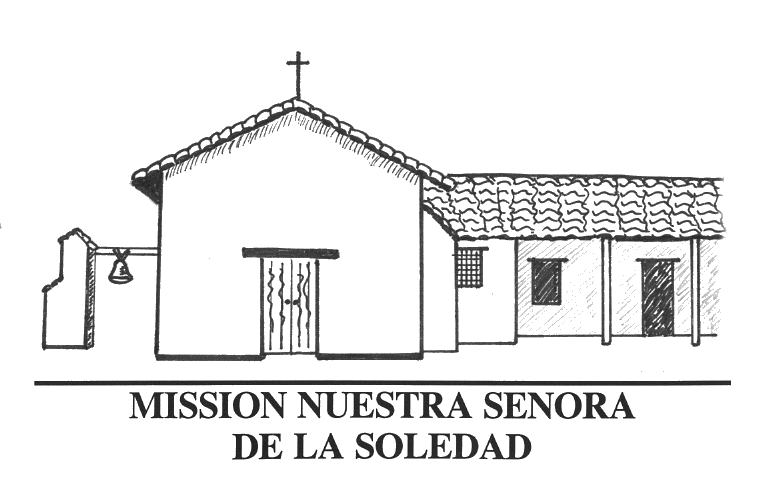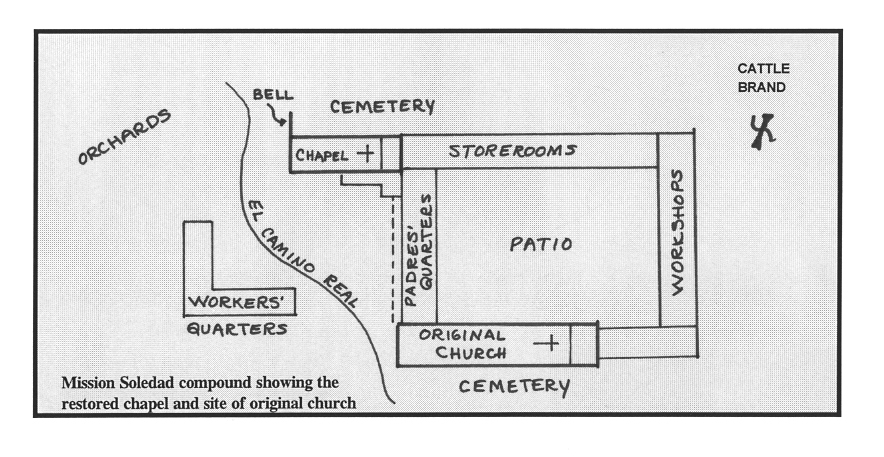| ||||
|
| ||||
|
MISSION
NUESTRA SENORA DE LA SOLEDAD
36641 Fort Romie Road
Soledad,
CA
93960
Established: October 9, 1791
By: Father Fermín Lasuén, Franciscan missionary and successor to Junípero Serra.
Order: 13th of the 21 missions.
Location: In the Salinas River Valley, about 30 miles SE of Monterey.
Named: Full name was Nuestra Señora Dolorosísima de la Soledad, for Our Lady the Most Sorrowful, Mary the mother of Jesus. Spanish visitors thought the Indians used the word soledad (Spanish for loneliness) to refer to themselves, and the area looked desolate.
California Historical Landmark No. 233
DESIGN OF THE MISSION
Church: Little is known of the original church. The building that has survived is a small chapel (about 60 feet long, 20 feet wide), converted from a part of a storehouse. Made of adobe; tile roof.
Style: Plain white building. Original paintings of the 14 stations of the cross adorn the walls of the chapel. Behind the altar is a statue of Mary dressed in the black mourning robes of a Spanish widow.
Bells: There is no bell tower or bell wall. A single bell, made in Mexico in the 1790's, hangs from a wooden beam near the chapel entrance.
Mission Compound: Building was slow at this mission and construction was repeatedly destroyed by flood, but at one time there was a small quadrangle of buildings adjoining the church. It had living quarters and storerooms, workshops for weavers, tanners, masons, carpenters, and blacksmiths.
Mission Grounds: Though the site was barren and dry when the mission was founded, irrigation soon created a fertile valley. At the peak of prosperity about 6,000 head of cattle and 6,400 sheep grazed on mission lands. In the fields, crops of horse peas, Spanish peas, corn, beans, and wheat were grown. A 20-acre vineyard produced grapes from which wine and brandy were made. Water was brought from the Salinas and Arroyo Seco Rivers through a five-mile system of cement aqueducts built by the Salinan Indians. Adobe huts for the workers were nearby.
The fact that Soledad was never a large nor prosperous mission may be due to the climate which was hot, dry and windy in summer, and freezing and wet in winter. There was much sickness, especially rheumatism, and most of the priests did not stay long at Soledad. An exception was Father Florencio Ibáñez, who spent 15 years here. Any mission was considered to be a place of refuge for anyone needing it, and Soledad, being so isolated, was sought out often for this purpose.

EARLY HISTORY
1769 Father Crespí first visited the area.
1771 Father Serra passed through and talked with local people.
1791 Mission was established, to be the halfway point between Mission San Antonio de Padua and the Carmel Mission.
1792 Temporary church of brushwood erected.
1797 First permanent church built of adobe with a thatched roof.
1805 Church enlarged; perhaps tile roof was added.
1824 Flooding from the river destroyed the church; replaced by a smaller chapel.
1828 Again floods destroyed buildings, including the chapel. Rebuilding was slow.
1832 More flooding and an earthquake damaged buildings; part of a storehouse converted into a chapel.
1834 Mission secularized, control taken by the government. Father Sarría, who had come in 1828, continued to serve as priest, but number of native workers diminished.
1835 Father Sarría died; everyone else left the mission; buildings began to decay.
1846 Mission sold; roof tiles sold to pay debts to the Mexican government. Buildings used as a ranch house for a few years, then abandoned.
1859 Buildings and 42 acres of land returned to the Catholic Church, but the property was left deserted and the buildings continued to disintegrate.
MISSION NUESTRA SENORA DE LA SOLEDAD TODAY
For almost a hundred years, Soledad Mission was abandoned to the weather. By the 1950's the only walls still standing were at one corner of the chapel. Under the care of the Native Daughters of the Golden West, a restoration project was begun.
In 1954 the small chapel was rebuilt using adobe bricks that were handmade from the dust of the old adobes. Gradually some of the original possessions of the mission are being located and returned to their places. The original bell once again hangs on a beam near the chapel entrance. The paintings of the stations of the cross and some of the original vestments (religious garments) had been preserved at other missions while Soledad was deserted. They have now been returned to Soledad.
The residence wing of the original quadrangle was rebuilt in 1963. Beyond it can be seen the ruins of the other buildings that once bordered the gardens. Excavation has uncovered the tile floor of the original church, with the graves of Father Ibáñez and Governor José Arrillaga, Spanish governor of Alta California frp, 1792-97 and 1800-14.
Soledad Mission is a part of the parish of Soledad, but no priest has served here on a regular basis since 1835. Services are held just four times a year. Visitors can appreciate the restored garden and a small museum. Further restoration efforts are being conducted by a local committee as funds are available. Each October a Mission Fiesta is held to raise money for the mission, as well as a barbecue fundraiser held each June.
